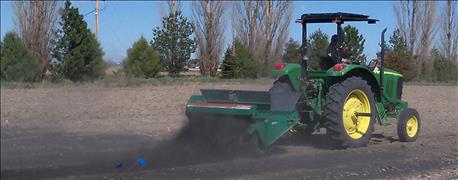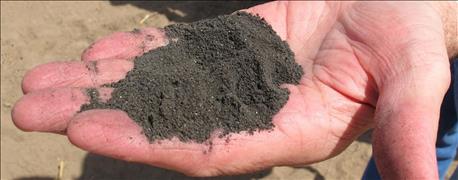June 12, 2016

University of Nebraska-Lincoln scientists have started a multi-year study researching whether high-carbon char can improve crop fields.
Each year Western Sugar Cooperative produces 35,000 tons of char, a fine, powdery coal dust byproduct from sugarbeet processing, at its sugar manufacturing plant in Scottsbluff.

SPREADING SUGARBEET CHAR: Char is spread onto research plots at the Mitchell Ag Lab, several miles north of the University of Nebraska Panhandle Research and Extension Center. The fine power is spread with a golf-course spreader.
Researchers from UNL's Panhandle Research and Extension Center and the Lincoln campus of UNL's Institute of Agriculture and Natural Resources are beginning a three-year study in which they will apply high-carbon char to research plots near Scottsbluff. The char will be applied at several rates (0 to 25 tons per acre), incorporated into the soil, and then crops will be planted in a four-year rotation that includes sugarbeets, corn, and dry edible beans.
The research team will measure crop yields as well as changes in the soil physical properties (infiltration, crusting, water holding capacity, density, color), and chemical properties (carbon, pH, salinity and soil nutrient levels).
Potential soil health benefits
The potential soil-quality benefits include an increase in organic matter and soil carbon. Higher concentrations of carbon in the soil reduce crusting, rapid soil-surface drying, and compaction and improve soil structure, water infiltration, water-holding capacity, and microbial activity. Decades of crop production have depleted organic matter and soil carbon from many fields in western Nebraska, according to Gary Hergert, retired soils specialist at the Panhandle Center. Hergert is advising the research.
This is one of a very few, and possibly the only, large field-plot-scale project in the U.S. to study the effects of biochar, Hergert said.

A FINE POWDER: Before it is spread onto fields, char is screened, eliminating larger particles and leaving a finer powder.
Research into biofuel alternatives to ethanol had been on the increase since growth in ethanol was capped in the new Renewable Fuel Standard by the Energy Independence and Security Act of 2007 (EISA). The new Renewable Fuel Standard capped production of corn ethanol, but called for increases in other types of biofuels that had a greater reduction in greenhouse gases. Hergert said this led to the expectation that other biofuel sources, such as cellulosic materials like irrigated grasses, would grow in importance.
One potential ethanol addition is second-generation biofuels created by pyrolysis, the heating of cellulosic substances to create an oil-like substance. Biochar is a leftover remain of pyrolysis. Research conducted elsewhere on its agronomic effects has been on small-scale, greenhouse-size plots, due to lack of federal funding and congressional follow-through that would support second-generation biofuels, according to Hergert.
Project to continue through 2018
Humberto Blanco, associate professor of soil management in the UNL Agronomy and Horticulture Department, is the principal investigator. Blanco, in Lincoln, has been collecting soil samples measuring the soil's physical properties.
In addition to Hergert, other project members include several faculty and staff at the Panhandle Center: Research Technicians Rex Nielsen and Les Kampbell; Dryland Cropping Systems Specialist Cody Creech; Integrated Weed Management Specialist Nevin Lawrence; and Associate Director Jim Schild. Steve Godby and David Reichert from Western Sugar are also working on the project.
In addition to the irrigated plots at Mitchell, char is being applied on dryland research plots at the High Plains Ag Lab under Creech's supervision.
This project is in its first year and is scheduled to continue through 2018.
Source: UNL CropWatch
You May Also Like




